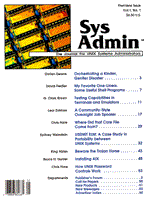Sidebar: The Basics
While this article focuses on the dkmap script as an
aid in
system restoration, any discussion of disaster recovery
would be remiss
if it didn't discuss the basics, however briefly.
All system administrators, whether tender novice or
wizened expert,
should consider these issues:
Plan your backup so that no more than four or five volume
sets are required for the complete recovery of a file
system. Just
reading tapes can be the most time-consuming part of
any recovery
process. Keep backup media well-labeled and if multiple
images are
saved to a single tape, keep track of that, too. Keep
a certain number
of full backups at a separate location in case of fire
or similar
catastrophe.
Make sure you have a current bootable tape (or CD) for
each architecture you support. If the media is tape,
try to keep two
copies per architecture. Tapes sometimes die, and their
favorite time
to die is 2:00 A.M., particularly if they sense desperation
in the air.
Assess your vulnerability. What are your single points
of failure? Is there any equipment in your configuration
that users
absolutely require to continue their work? If so, do
you have the
coverage you need, either in the form of spare parts
or a maintenance
contract?
If you keep these points in mind, your disaster will
be a kinder, gentler one.
|
